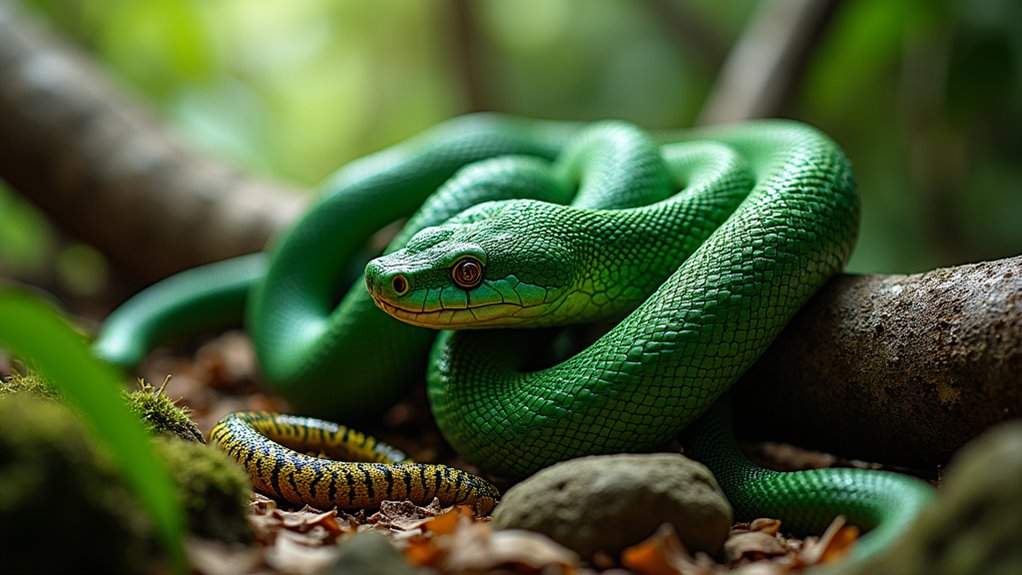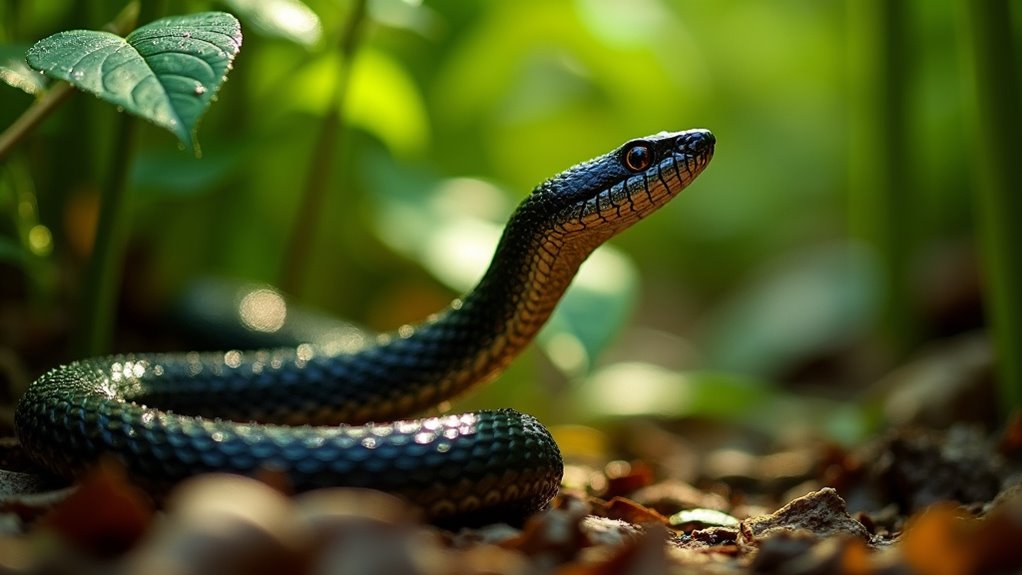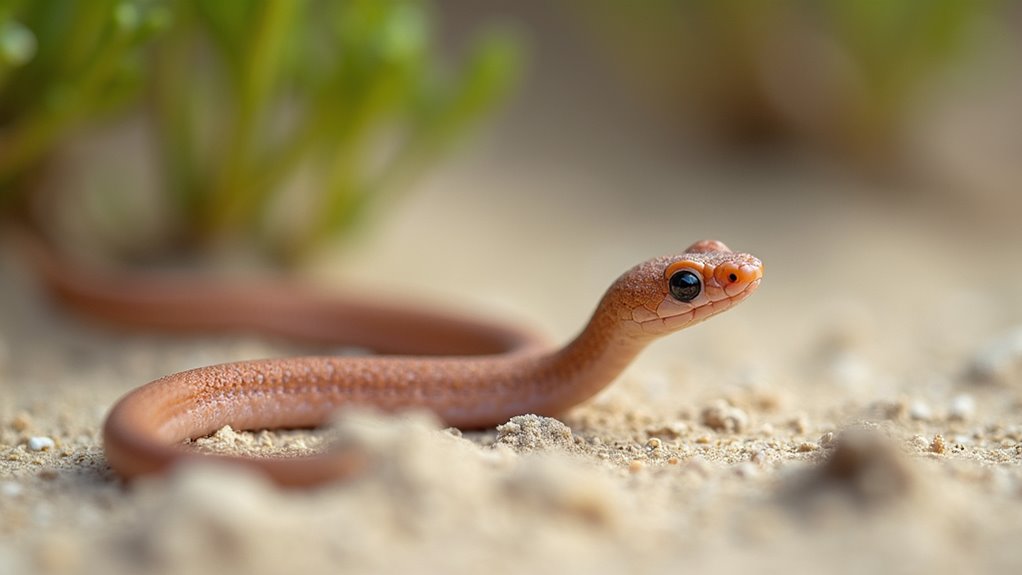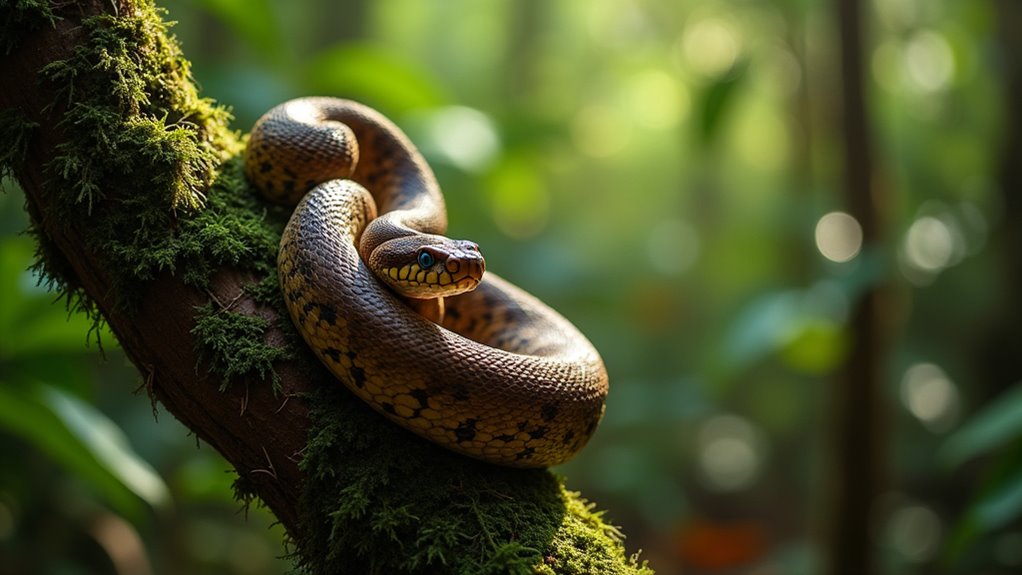Physical Address
304 North Cardinal St.
Dorchester Center, MA 02124
Physical Address
304 North Cardinal St.
Dorchester Center, MA 02124

Hidden beneath Puerto Rico's lush canopies, five extraordinary snake species slither with unique adaptations that will astonish wildlife enthusiasts.
Did you know that Puerto Rico hosts over 100 reptile species despite its relatively small size? If you’re exploring this Caribbean island’s wildlife, you’ll want to understand its remarkable native snakes. From the imposing Puerto Rican Boa that hunts by constriction to the tiny, secretive Coastal Blindsnake that lives underground, these creatures play essential roles in their ecosystems. The island’s serpents have fascinating adaptations and behaviors that reveal much about Puerto Rico’s unique biodiversity and conservation challenges.

Among Puerto Rico’s diverse snake species, the Puerto Rican Racer is notable as one of the most intriguing inhabitants of the island. Endemic to Puerto Rico and the Virgin Islands, this snake grows up to 3 feet long with a solid brown body and distinctive dark-edged scales.
You’ll recognize it by its cobra-like appearance—it raises its forebody defensively and has a narrow neck hood, though unlike true cobras, it only displays this hood when provoked.
While primarily found in El Yunque and Toro Negro forests, citizen science reports show it’s distributed across many municipalities. The snake has been observed slinking through trees in these forested habitats.
This diurnal hunter preys on lizards and small rodents using a bite-and-hold strategy. Unlike some of Ohio’s venomous snake species, the Puerto Rican Racer poses no significant threat to humans. Though experiencing population declines linked to human activity, it remains one of Puerto Rico’s most remarkable reptiles.
Towering over other local serpent species as Puerto Rico’s largest snake, the Puerto Rican Boa stretches an impressive 6 to 7 feet in length with its pale to dark brown coloration providing perfect camouflage in the island’s diverse habitats.
Majestic giants of the island, Puerto Rican Boas blend perfectly into their surroundings while ruling the local snake kingdom.
This gentle giant lives both in trees and on the ground, making its home in forests and caves across the island. The species thrives particularly in the northwestern karst region where limestone formations create ideal habitat.
You’ll find these non-venomous constrictors hunting small mammals, birds, and lizards. They’re particularly skilled at catching bats in pitch-dark caves. Unlike many venomous species found on the mainland, Puerto Rican boas pose no threat to humans.
Unlike most reptiles, they give birth to live young rather than laying eggs.
Their ecological importance can’t be overstated—they control pest populations that would otherwise multiply unchecked.
Despite their beneficial role, these snakes aren’t widely appreciated, leaving their conservation status somewhat unclear.

Hidden beneath Puerto Rico’s sandy coastal soils, the diminutive Coastal Blindsnake (Antillotyphlops hypomethes) leads a secret life most islanders never witness. This small, cylindrical reptile has evolved perfectly for its subterranean lifestyle with a blunt head for burrowing, reduced eyes, and a short tail.
Unlike its relative the wetland blindsnake, this species prefers drier coastal habitats where it hunts for ants and termites. You’ll rarely spot these nocturnal creatures as they spend most of their time underground, using concertina movements to navigate through soil. While exploring Puerto Rico’s beaches, you might find better luck spotting these creatures near Sanibel Island where snorkeling visibility is often exceptional. Enthusiasts and researchers often document sightings of this elusive species on iNaturalist Canada platform.
Though not currently listed as endangered, their specialized habitat makes them vulnerable to coastal development. If you’re exploring Puerto Rico’s beaches, remember these tiny soil engineers are working beneath your feet, aerating the soil and controlling insect populations.
Puerto Rico’s snake diversity extends beyond the secretive blindsnakes to include remarkable color variations across subspecies. If you encounter the Alsophis portoricensis portoricensis, you’ll notice its chocolate brown coloration with dark-edged scales and distinctive white anterior scale edging. It’s the largest and most widespread subspecies, reaching nearly 4 feet with an unmarked head and pale throat.
In contrast, Alsophis portoricensis prymnus displays a tannish-brown base with a reticulated pattern resembling a dark network. You’ll find it’s smaller (about 2 feet) with a reddish underside, primarily in southern areas including Caja de Muertos Island. Nature enthusiasts often include this location in their backpacking itineraries when exploring Puerto Rico’s diverse ecosystems.
Unlike some Caribbean relatives, Puerto Rican species show no sexual color differences. However, geographic adaptations exist, with mainland specimens exhibiting darker pigmentation while island populations feature lighter ventral hues. The Mona Island subspecies, Alsophis portoricensis variegatus, is particularly striking with its reticulated dorsum pattern and distinctive dark face mask.

Despite significant conservation progress, Puerto Rico’s native snakes face ongoing challenges that demand continued attention. The Puerto Rican boa, once endangered, has rebounded to an estimated population of over 30,000, demonstrating remarkable resilience despite habitat loss and human persecution.
You’ll find these important predators protected in areas like El Yunque National Forest and lands managed by the Puerto Rico Conservation Trust. Historically, these snakes were once abundant during colonization but experienced severe population decline due to deforestation and possible mongoose predation. Their ecological value is immense—they help control rodent populations while contributing to the island’s biodiversity with their relatively high genetic diversity.
Though proposed for delisting in 2022, these boas remain vulnerable to road mortality, development conflicts, and climate change impacts. Visitors interested in wildlife might consider exploring both US states like Montana and Wyoming before or after their Puerto Rico adventure to compare diverse ecosystems. When visiting Puerto Rico, remember that supporting conservation efforts and changing negative attitudes toward these snakes helps ensure their continued role in maintaining the island’s ecological balance.
As you explore Puerto Rico’s diverse landscapes, you’ll discover these five serpents playing their David and Goliath roles in the ecosystem. From the majestic boa to the tiny blindsnake, they’re critical inhabitants of this island paradise. Your understanding of these native snakes won’t just satisfy curiosity—it’ll help support ongoing conservation efforts to protect Puerto Rico’s natural heritage for generations to come.